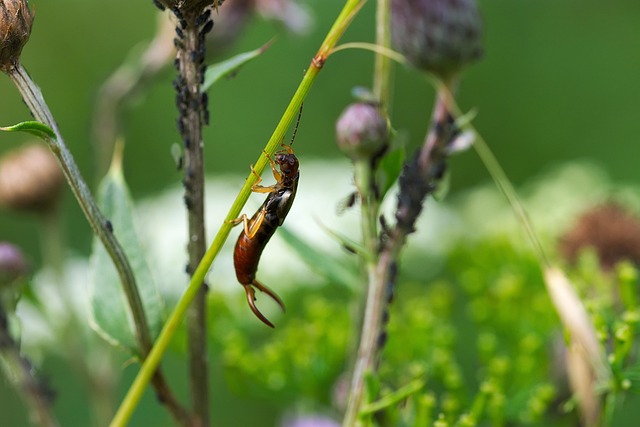To effectively treat earwig infestations in residential areas, homeowners should focus on modifying their environment. This includes reducing moisture, sealing entry points, and creating an unappealing landscape for earwigs. Natural solutions like aromatic plants and strategic gardening can deter earwigs, while incorporating beneficial insects supports ecosystem balance. Combining these methods provides a comprehensive and eco-friendly residential earwig treatment.
Discover effective landscaping techniques to reduce earwig habitats and achieve successful residential earwig treatment. Understanding these pests’ preferences is key, guiding the implementation of physical barriers and strategic landscaping changes. Learn how specific plant choices can deter earwigs naturally, and explore beneficial insects that offer eco-friendly control solutions. By integrating these methods, homeowners can create an earwig-unfavorable environment, ensuring a comfortable living space.
Understanding Earwigs and Their Habitat Preferences
Earwigs are insects known for their distinctive appearance and often unwelcome presence in homes, particularly in residential areas. Understanding their habitat preferences is a crucial step in implementing effective earwig treatment methods. These pests thrive in dark, damp environments, making them drawn to spaces like cracks, crevices, and vegetative zones with rich moisture content. In residential settings, earwigs commonly inhabit gardens, landscaping features, and the areas around foundations.
The preference for moist and shaded areas means that well-maintained lawns with proper drainage and minimal foliage against walls can significantly deter earwig activity. Regularly trimming vegetation and addressing water buildup issues in the landscape are practical strategies to reduce earwig habitats, thereby enhancing the overall effectiveness of any residential earwig treatment approach.
Implementing Physical Barriers and Landscaping Changes
Implementing Physical Barriers and Landscaping Changes is a proactive approach to earwig prevention in residential areas. One effective method involves introducing natural physical barriers that deter these insects from entering homes. For instance, sealing cracks and gaps around doors, windows, and utility pipes with caulk or weatherstripping creates a tight seal, blocking access points for earwigs. Additionally, installing mesh screens over vents and drains allows for ventilation while preventing the pests from infiltrating indoor spaces.
Landscaping modifications play a significant role in earwig management. Maintaining a clean, tidy garden is essential. Removing excessive vegetation, especially near entry points like windows and doors, reduces hiding spots and makes it harder for earwigs to find their way inside. Trimming shrubs and trees regularly and keeping the lawn mowed creates an unappealing environment for these insects, encouraging them to seek habitats elsewhere.
Utilizing Plant Choices to Deter Earwigs
Many people turn to professional residential earwig treatments, but there are natural and cost-effective solutions that can be just as effective in reducing earwig habitats. One such solution lies in strategic plant choices. Certain plants have properties that deter earwigs naturally. For instance, lavender, mint, rosemary, and thyme are known to repel these pests due to their strong scents. Incorporating these aromatic plants into your garden landscape can significantly reduce the appeal of your yard to earwigs.
Additionally, planting a diverse array of flora creates an environment that disrupts earwigs’ preference for hiding spots and food sources. Plants with rough textures or thorny leaves also make it harder for earwigs to navigate and settle in your garden. This layered approach not only discourages earwigs but also adds aesthetic value and promotes a healthier, more balanced ecosystem in your residential landscape.
Natural Repellents and Beneficial Insects for Residential Control
Natural repellents can be a safe and effective way to deter earwigs from residential areas. Certain plants, such as lavender, mint, basil, and lemongrass, are known to repel these pests due to their strong scents. Planting these herbs around your home’s perimeter or in garden beds can create a natural barrier against earwigs. Additionally, some essential oils like citronella, peppermint, and tea tree oil have insecticidal properties and can be used in homemade repellents or diffusers to keep earwigs at bay.
Incorporating beneficial insects into your residential earwig treatment strategy is another eco-friendly option. Certain types of wasps, for instance, lay their eggs inside earwig nests, killing the larvae. Predatory mites and nematodes are also effective in controlling earwig populations as they parasitize or feed on these pests. Encouraging the presence of these beneficial insects through specific plant choices and habitat creation can help maintain a balanced ecosystem while reducing earwig habitats in residential areas.
By understanding earwig habitat preferences and implementing targeted landscaping techniques, homeowners can significantly reduce these pests’ appeal. Physical barriers and strategic plant choices play a vital role in creating an earwig-unfriendly environment. For a comprehensive residential earwig treatment, combining these natural methods with beneficial insects offers an effective, eco-conscious solution. These strategies not only minimize the presence of earwigs but also contribute to a healthier, more balanced garden ecosystem.
